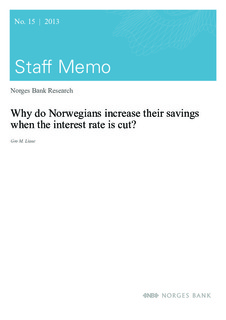| dc.contributor.author | Liane, Gro M. | |
| dc.date.accessioned | 2018-07-31T12:14:03Z | |
| dc.date.available | 2018-07-31T12:14:03Z | |
| dc.date.issued | 2013 | |
| dc.identifier.isbn | 978-82-7553-767-4 | |
| dc.identifier.issn | 1504-2596 | |
| dc.identifier.uri | http://hdl.handle.net/11250/2506992 | |
| dc.description.abstract | This note aims to shed light on the relationship between interest rates and household savings in Norway. To this end, I use a simple life-cycle model that accounts for actual debt levels of Norwegian households. The starting point is that since Norwegian households tend to have negative net financial wealth, a low interest rate makes them better off. In a nutshell, reduced interest rate payments can be viewed as a transitory income increase. When households wish to smooth consumption, only a small fraction of the transitory income gift will be consumed, while most of the reduced income payments will be saved for consumption in future periods. Hence, a life-cycle model is able to explain why households increase savings when interest rates are low. | nb_NO |
| dc.language.iso | eng | nb_NO |
| dc.publisher | Norges Bank | nb_NO |
| dc.relation.ispartofseries | Staff Memo;15/2013 | |
| dc.rights | Attribution-NonCommercial-NoDerivatives 4.0 Internasjonal | * |
| dc.rights.uri | http://creativecommons.org/licenses/by-nc-nd/4.0/deed.no | * |
| dc.title | Why Do Norwegians Increase Their Savings When the Interest Rate Is Cut? | nb_NO |
| dc.type | Working paper | nb_NO |
| dc.subject.nsi | VDP::Samfunnsvitenskap: 200::Økonomi: 210 | nb_NO |
| dc.source.pagenumber | 25 | nb_NO |

